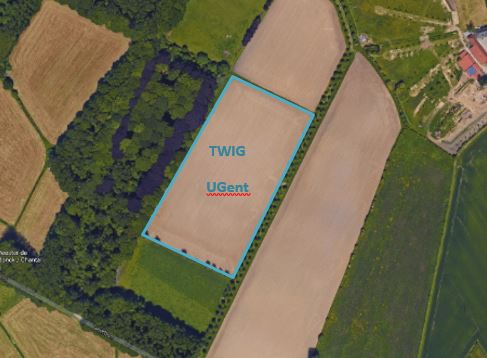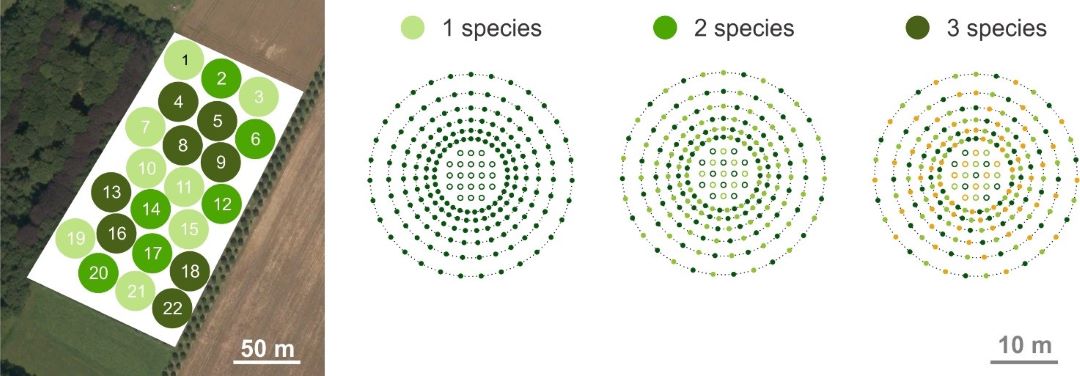TWIG UGent (Belgium)
The acronym TWIG stands for Tree Wheels In Geerbos. This ‘climate forest’ was planted by Ghent University (UGent) as a symbol for its sustainability ambitions and to sequester a little bit of their CO2 emission. The experiment was established near Geerbos in Melle in 2017. Circular plots were planted with one up to three tree species and from high to low tree density.

Design
The experiment consists of circular plots that follow the Nelder Wheel design. Trees are planted along concentric circles with increasing radii. Hence, the planting density is higher in the center of the plots than at the plot border. The central area of the wheels is planted as well, but those trees are not part of the Nelder design. The plots are planted with one up to three tree species from a species pool of four species: two associated with ectomycorrhiza (Fagus sylvatica, Quercus robur), two with arbuscular mycorrhiza (Acer pseudoplatanus, Prunus avium). All four monocultures, the six 2-species mixtures, and the four 3-species mixtures are planted. The monocultures and 3-species mixtures are replicated once. Mixing is on a tree by tree level within plots. The plots are grouped into blocks that represent ‘close to forest edge’ vs. ‘non forest edge’ and ‘deep clay’ vs. ‘more shallow clay’.

Site characteristics
| TWIG (Melle) | |
|---|---|
| Country | Belgium |
| Biome | temperate |
| Latitude | 50.99 |
| Longitude | 3.83 |
| Soil type | Retisol (WRB) Ldc - moist, sandy silt with degraded texture B horizon (Belgian Soil Classification System) |
| Former land use | arable field, maize |
| Altitude | 16 m |
| Design | stem-wise regular |
| Plot shape | circular |
| Plot size (m^2) | 774.37 m² |
| Plant distance (m) | variable (31 trees per circle, circles with radius 5.7, 7, 8.6, 10.5, 12.8, 15.7 m) |
| Number of trees planted | 4598 |
| Planting date | February 2017 |
| Diversity variables | species richness functional diversity |
| Diversity gradient | 1,2,3 sp. AM, EM, fungi |
| Size species pool | 4 |
| Species pool | Acer pseudoplatanus Prunus avium Fagus sylvatica Quercus robur |
| Contact person | Kris Verheyen |
| kris.verheyen@UGent.be |
Research
The main research focus is investigating how tree density affects the diversity effects on tree growth and carbon sequestration.
Extra information
Send an e-mail to the contact person, visit the experiment’s website, or explore the publications that utilized data from this experiment.
Research papers
- Blondeel H, Guillemot J, Martin‐StPaul N, Druel A, Bilodeau‐Gauthier S, Bauhus J, … Baeten L 2024 Tree diversity reduces variability in sapling survival under drought. Journal of Ecology 112(5): 1164-1180 - https://doi.org/10.1111/1365-2745.14294
- Luo S, Schmid B, Hector A, Scherer‐Lorenzen M, Verheyen K, Barsoum N, Bauhus J, Beyer F, Bruelheide H, Ferlian O, Godbold D, Hall JS, Hajek P, Huang Y, Hölscher D, Kreft H, Liu X, Messier C, Nock C, Paquette A, Parker JD, Parker WC, Paterno GB, Reich PB, Rewald B, Sandén H, Sinacore K, Stefanski A, Willams L, Eisenhauer N 2024 Mycorrhizal associations modify tree diversity− productivity relationships across experimental tree plantations. New Phytologist 243:1205-1219 - doi: 10.1111/nph.19889
- Depauw L, De Lombaerde E, Dhiedt E, Blondeel H, Abdala-Roberts L, Auge H, Barsoum N, Bauhus J, Chu C, Damtew A, Eisenhauer N, V. Fagundes M, Ganade G, Gendreau-Berthiaume B, Godbold D, Gravel D, Guillemot J, Hajek P, Hector A, Hérault B, Jactel H, Koricheva J, Kreft H, Liu X, Mereu S, Messier C, Muys B, Nock CA, Paquette A, Parker JD, Parker WC, Paterno, GB, Perring MP, Ponette Q, Potvin C, Reich PB, Rewald B, Scherer-Lorenzen M, Schnabel F, Sousa-Silva R, Weih M, Clara Zemp D, Verheyen K, Baeten L 2024 Enhancing Tree Performance Through Species Mixing: Review of a Quarter-Century of TreeDivNet Experiments Reveals Research Gaps and Practical Insights. Current Forestry Reports - https://doi.org/10.1007/s40725-023-00208-y
- FAO 2023 Towards more resilient and diverse planted forests. Unasylva (254)74: 2031/1. Rome. https://doi. org/10.4060/cc8584en
- Messier C, Bauhus J, Sousa-Silva R, Auge H, Baeten L, Barsoum N, Bruelheide H, Caldwell B, Cavender-Bares J, Dhiedt E, Eisenhauer N, Ganade G, Gravel D, Guillemot J, Hall JS, Hector A, Hérault B, Jactel H, Koricheva J, Kreft H, Mereu S, Muys B, Nock CA, Paquette A, Parker JD, Perring MP, Ponette Q, Potvin C, Reich PB, Scherer-Lorenzen M, Schnabel F, Verheyen K, Weih M, Wollni M, Zemp DC 2021 For the sake of resilience and multifunctionality, let’s diversify planted forests! Conservation Letters e12829 - https://doi.org/10.1111/conl.12829
